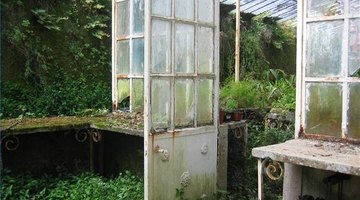How to Make a Green House From Old Windows
Building a greenhouse doesn't have to be an expensive proposition.

If you have access to old windows and moderate do it yourself building and carpentry skills, you can create an attractive and efficient greenhouse to extend your growing season or grow plants that require more temperate conditions than your growing region normally allows.
-
Check your local building codes for ordinances about built structures on your property. Knowing the building codes regarding your project will help you plan appropriately from the start. It's no fun to have to tear down your work or revise everything halfway through because your building isn't up to code.
-
Determine the size of your greenhouse, taking into account both your materials and the space you have available on which to build. An 8- by 10-foot greenhouse will give you enough room for 100 or more plants if you plan it carefully.
-
Choose the site of your greenhouse. Common advice is to build a lean-to structure against a south-facing wall of your house, but any area that gets plenty of sun will do.
-
Study greenhouse construction plans for ideas and advice before beginning to design your own greenhouse. Because you'll be using recycled materials and finished windows, most plans won't be perfect for your greenhouse, but you can get valuable ideas and advice from professional plans.
-
Sketch out your plan on paper to help you determine what additional wood and materials you'll need before you start building.
-
Lay out the lines for your foundation using stakes and string. Drive a stake into the ground at each corner of your planned foundation. Run string between the stakes to determine the line for your footing.
-
Dig a trench 1-foot deep and 2-feet wide along your marked lines. The dimensions of the trench may vary according to your local building code. Build concrete forms from plywood inside the trenches, or rent prefab forms to fit. Reinforce with steel rods or rebar before pouring concrete.
-
Pour concrete, leaving 1/4- to 1/2-inch D-anchors protruding from the top of the footing. These will allow you to attach the walls of your greenhouse firmly to the foundation. Also leave drainage openings around the foundation. Allow concrete to cure before removing concrete forms.
-
Excavate the floor area of your greenhouse to a depth of at least 6 inches. Make sure that the base of the floor is level and smoothed by pounding the dirt with a tamper. You may choose to pour a concrete floor or build up from the dirt base.
-
Fill floor excavation with crushed gravel to 4 inches. Top gravel with tar paper or construction plastic to form a vapor barrier. Add 2 to 4 inches of fine builders sand and tamp well.
-
Lay out bricks for floor, making sure that the bricks fit closely. After the floor is laid, pour fine builders sand over the entire floor and sweep it into crevices between bricks to secure them.
-
Create vertical posts using 4 x 4s set against the inside of the building foundation. Bolt and secure the posts to the foundation using the D bolts set into the concrete.
-
Assemble the walls on a flat surface, using 2 x 6 or 2 x 4 lumber. Mount them on the verticals and nail them in place. Keep in mind that the roof should have a slight pitch to allow for drainage, so the top ends of the verticals should be cut to allow for a slope.
-
Assemble the roof frame after the walls have been mounted and nail it in place.
-
Attach windows to framing by driving nails directly through the wooden window frames, using enough nails to attach them firmly.
-
Cover roof framing with roofing felt or your choice of roofing material. To avoid overheating the greenhouse, it is not advisable to use windows for the entire roof.
-
Add finishing touches, including shelving and benches for staging.
Things You Will Need
- Old wood framed windows
- Sand and bricks for floor
- Concrete for footings
- Framing lumber
- Nails and screws
- Basic carpentry tools
Tip
Cut your work in half and ensure a good foundation by outsourcing the foundation building to a professional. Rent a tamper from your local rental company to cut down on the work of tamping the floor. Design your wall frames around your salvaged windows rather than trying to fit the windows to the frame after the fact.
Warning
Always wear eye protection when working with construction equipment to avoid eye injury. Remember to leave drainage holes in your foundation to avoid wood rot.
Writer Bio
Deb Powers is an avid urban gardener who works with a community collective to promote sustainable urban agriculture and build partnerships between local business owners and community organizations. Powers serves as a social media and marketing consultant for local non-profits and businesses, and is collaborating with a coffee roaster to publish a cookbook highlighting coffee as a culinary ingredient.
Photo Credits
- ladyleaf@stockexchange
- ladyleaf@stockexchange
More Articles



